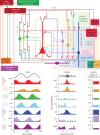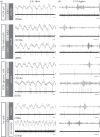Temporal redistribution of inhibition over neuronal subcellular domains underlies state-dependent rhythmic change of excitability in the hippocampus
- PMID: 24366131
- PMCID: PMC3866441
- DOI: 10.1098/rstb.2012.0518
Temporal redistribution of inhibition over neuronal subcellular domains underlies state-dependent rhythmic change of excitability in the hippocampus
Abstract
The behaviour-contingent rhythmic synchronization of neuronal activity is reported by local field potential oscillations in the theta, gamma and sharp wave-related ripple (SWR) frequency ranges. In the hippocampus, pyramidal cell assemblies representing temporal sequences are coordinated by GABAergic interneurons selectively innervating specific postsynaptic domains, and discharging phase locked to network oscillations. We compare the cellular network dynamics in the CA1 and CA3 areas recorded with or without anaesthesia. All parts of pyramidal cells, except the axon initial segment, receive GABA from multiple interneuron types, each with distinct firing dynamics. The axon initial segment is exclusively innervated by axo-axonic cells, preferentially firing after the peak of the pyramidal layer theta cycle, when pyramidal cells are least active. Axo-axonic cells are inhibited during SWRs, when many pyramidal cells fire synchronously. This dual inverse correlation demonstrates the key inhibitory role of axo-axonic cells. Parvalbumin-expressing basket cells fire phase locked to field gamma activity in both CA1 and CA3, and also strongly increase firing during SWRs, together with dendrite-innervating bistratified cells, phasing pyramidal cell discharge. Subcellular domain-specific GABAergic innervation probably developed for the coordination of multiple glutamatergic inputs on different parts of pyramidal cells through the temporally distinct activity of GABAergic interneurons, which differentially change their firing during different network states.
Keywords: GABA; inhibition; interneuron; oscillation; synapse.
Figures



Similar articles
-
Complementary roles of cholecystokinin- and parvalbumin-expressing GABAergic neurons in hippocampal network oscillations.J Neurosci. 2005 Oct 19;25(42):9782-93. doi: 10.1523/JNEUROSCI.3269-05.2005. J Neurosci. 2005. PMID: 16237182 Free PMC article.
-
Network state-dependent inhibition of identified hippocampal CA3 axo-axonic cells in vivo.Nat Neurosci. 2013 Dec;16(12):1802-1811. doi: 10.1038/nn.3550. Epub 2013 Oct 20. Nat Neurosci. 2013. PMID: 24141313 Free PMC article.
-
Cell type-specific tuning of hippocampal interneuron firing during gamma oscillations in vivo.J Neurosci. 2007 Aug 1;27(31):8184-9. doi: 10.1523/JNEUROSCI.1685-07.2007. J Neurosci. 2007. PMID: 17670965 Free PMC article.
-
Network mechanisms of gamma oscillations in the CA3 region of the hippocampus.Neural Netw. 2009 Oct;22(8):1113-9. doi: 10.1016/j.neunet.2009.07.024. Epub 2009 Jul 22. Neural Netw. 2009. PMID: 19683412 Review.
-
GABAergic interneurons targeting dendrites of pyramidal cells in the CA1 area of the hippocampus.Eur J Neurosci. 2009 Sep;30(6):947-57. doi: 10.1111/j.1460-9568.2009.06913.x. Epub 2009 Sep 4. Eur J Neurosci. 2009. PMID: 19735288 Review.
Cited by
-
Chandelier Cells in Functional and Dysfunctional Neural Circuits.Front Neural Circuits. 2016 May 4;10:33. doi: 10.3389/fncir.2016.00033. eCollection 2016. Front Neural Circuits. 2016. PMID: 27199673 Free PMC article. Review.
-
Unit Activity of Hippocampal Interneurons before Spontaneous Seizures in an Animal Model of Temporal Lobe Epilepsy.J Neurosci. 2015 Apr 22;35(16):6600-18. doi: 10.1523/JNEUROSCI.4786-14.2015. J Neurosci. 2015. PMID: 25904809 Free PMC article.
-
Single Bursts of Individual Granule Cells Functionally Rearrange Feedforward Inhibition.J Neurosci. 2018 Feb 14;38(7):1711-1724. doi: 10.1523/JNEUROSCI.1595-17.2018. Epub 2018 Jan 15. J Neurosci. 2018. PMID: 29335356 Free PMC article.
-
Control of recollection by slow gamma dominating mid-frequency gamma in hippocampus CA1.PLoS Biol. 2018 Jan 18;16(1):e2003354. doi: 10.1371/journal.pbio.2003354. eCollection 2018 Jan. PLoS Biol. 2018. PMID: 29346381 Free PMC article.
-
Neocortical calretinin neurons in primates: increase in proportion and microcircuitry structure.Front Neuroanat. 2014 Sep 25;8:103. doi: 10.3389/fnana.2014.00103. eCollection 2014. Front Neuroanat. 2014. PMID: 25309344 Free PMC article. Review.
References
-
- Buzsaki G. 2006. Rhythms of the brain. New York, NY: Oxford University Press.
-
- O'Keefe J, Nadel L. 1978. The hippocampus as a cognitive map. Oxford, UK: Clarendon.
Publication types
MeSH terms
Substances
Grants and funding
LinkOut - more resources
Full Text Sources
Other Literature Sources
Miscellaneous

